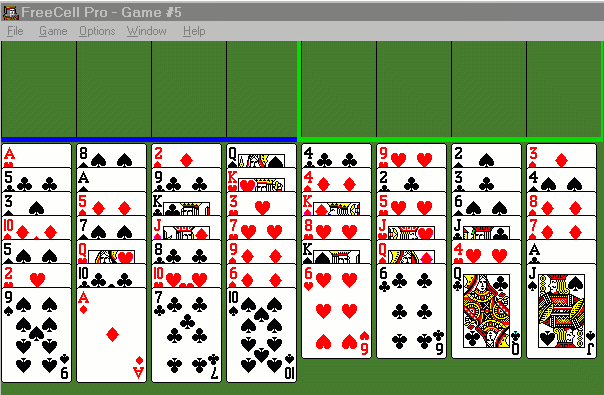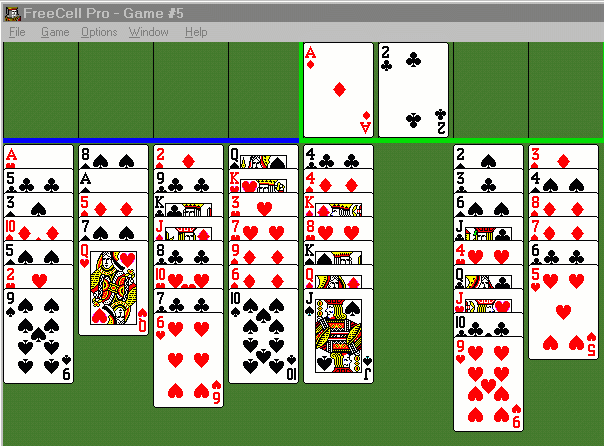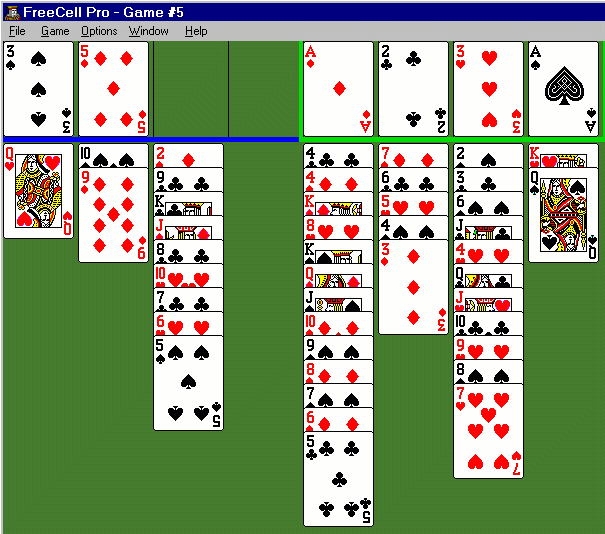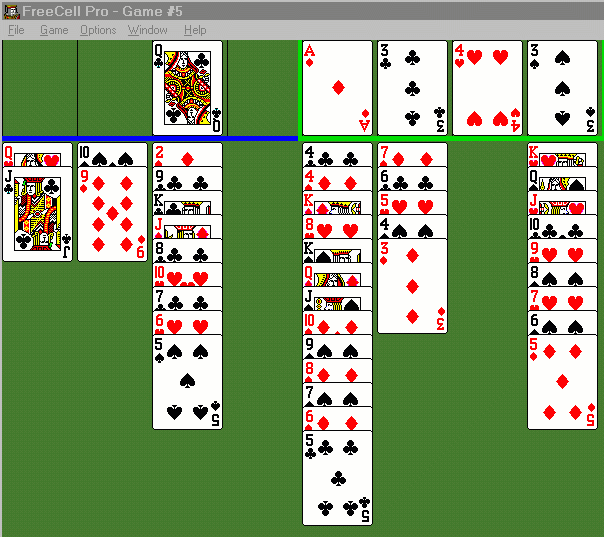Copyright ©2001, 2009 by Michael Keller. All rights reserved.
This page was revised on February 3, 2009.
If you've never played FreeCell before, or have had little or no success winning games, perhaps it would help to take you move-by-move through an entire deal. (You'll need to follow along with deal number 5 in Microsoft FreeCell, FreeCell Pro, or some other program which uses the same numbering system. If you are using FCPro, ignore all references to dialog boxes, since FCPro moves sequences to empty columns whenever possible.) Some programs, such as Pretty Good Solitaire, use a drag-and-drop interface rather than the click-to-select system typical in most FreeCell programs. PGS has the same numbering system as Microsoft for the first 1,000,000 deals, so you can follow this tutorial, but it will get tricky in spots.
The object of FreeCell is to play all 52 cards onto four piles (one pile of each suit) in the upper right of the screen, starting with the ace of each suit, and continuing with the two, three, etc., up to the king of each suit. Any ace which is free (not covered by another card) can be moved to one of the homecell spaces at the upper right. In fact, once you start the game by moving any card, any free aces will be moved there automatically by the program. Once an ace is on a homecell pile, the two of the same suit can be moved there whenever it is free, etc.

Let's start with an easy game, number 5. There are three kinds of legal moves:
(1) moving a free ace of a suit (or the next highest card when there are already cards of that suit there) to a homecell. The ace of diamonds can be moved to any homecell by clicking it once to select it (the card appears as a negative image), then clicking on one of the homecells.
(2) moving any free card (an uncovered card at the bottom of any column) to a freecell (one of the four spaces at the upper left) or an empty column. The nine of spades, seven of clubs, or ten of spades, etc., can be moved to a freecell (these are examples; don't make any of these moves now) by clicking it to select it, then clicking on an empty freecell. Once on a freecell, a card is available at any time, and can be moved to a homecell if allowed by rule (1) or onto a column if allowed by rule (3). A card which is the only card in its column is available too, of course.
(3) moving any free card onto another free card, provided it is of the opposite color (black suits on red, red suits on black) and one lower in rank. If you're familiar with the ordinary kind of solitaire (also known as Klondike), this is the same kind of move seen there. In game 5, you may begin by moving the six of hearts onto the seven of clubs. Note that the free ace of diamonds moves automatically to a homecell when you do this.
What are you trying to do early in the game? Normally to free up aces and to start clearing out columns, without using up too many of the freecells. You've already moved the six of hearts onto the seven of clubs. Now try out the following moves in game 5: the six of clubs to a freecell, the queen of diamonds onto the king of spades, the jack of hearts onto the queen of clubs, the jack of spades onto the queen of diamonds (the free ace of clubs moves automatically to another homecell). Now move the six of clubs from its freecell onto the seven of diamonds, and the five of hearts onto the six of clubs. The free two of clubs now moves automatically onto the club homecell. We're off to a good start, with two homecell piles started, and all four of the freecells empty. Move the ten of clubs onto the jack of hearts, and the nine of hearts onto the ten of clubs.

Now column six is empty. If you completely empty out a column, you may move any free card there (from a freecell or the bottom of any other column). We'll come back to that in a moment. First let's continue by working on column 1. Move the nine of spades to a freecell (note that there is a red ten deeper in the column, and we will aim to get the nine onto that ten), and the two of hearts to another freecell (we're going to get the ace of hearts free, so the two will go to its homecell soon). Move the five of spades onto the six of hearts, and the ten of diamonds (followed by the nine of spades) onto the jack of spades. Now move the three of spades and the five of clubs each to a freecell, and the ace of hearts and two of hearts automatically move to a new homecell.
Normally only one card at a time can be moved, but if you have several cards in sequence (downward in alternating colors), you can move them all at once if you have enough freecells empty (all four freecells empty means you can move five cards, three freecells let you move four, etc.; one freecell lets you move two cards). Since you have two freecells available, you can move three cards in sequence from the bottom of one column to an empty column, or, provided you are continuing a legal sequence, to the bottom of another column. This is not a special rule -- it's just a program shortcut to let you do quickly what you could do anyway moving one card at a time.
Whenever you try to move a sequence of cards from the bottom of a column to an empty column, the program will put up a dialogue box, asking you whether you want to move a sequence (column) of cards or just a single card. Click on the five of hearts now to select it, then click on the empty sixth column. When the dialogue box comes up, click on the Move Column box. The three-card sequence (five of hearts, six of clubs, seven of diamonds) will then move to the empty sixth column (if you have animation turned on, by having the Quick Play box unchecked under Game Options, you can see the five of hearts and the six of clubs quickly flash to the freecells, then back onto the seven of diamonds). [FCPro: animation is turned on by default; this is in the Animation menu under Options.]
Next move the eight of diamonds onto the nine of spades, and the four of spades and three of diamonds onto the five of hearts, clearing column eight. Next move the queen of hearts into the empty first column (no dialog box comes up since the queen is not in sequence with any other cards). Move the seven of spades onto the eight of diamonds, the five of diamonds to a freecell (sending the ace of spades home), and the eight of spades onto the nine of hearts. Since we only have one freecell available, we want to move some of the cards from the freecells back onto columns. Move the ten of spades into the empty second column, the six of diamonds (followed by the five of clubs) onto the seven of spades, the nine of diamonds onto the ten of spades, and the seven of hearts onto the eight of spades.
Why doesn't the free three of hearts move automatically now to the hearts homecell? Because the program sees the two of spades at the top of the seventh column, and thinks you may want to move it onto the red three later. Although this is a sound rule generally, it is overcautious in this case, since the two of spades can be moved onto the ace of spades as soon as it is free. So it is perfectly safe to move the three of hearts to its homecell, and you can do so yourself by selecting it, then clicking on the two of hearts. Now reverse the backwards sequence in the fourth column by moving the king of hearts, followed by the queen of spades, to the empty eighth column. If we didn't have an empty column available, it would still have been possible to reverse the king-queen sequence by moving both cards to freecells, then back into the fourth column in proper order (king first). It is usually sound strategy to reverse sequences in this way (we did so a little earlier with the four of spades and three of diamonds), and also to build sequences starting with the king into empty columns. But aren't we building up rather long sequences in columns five and seven, with lots of cards trapped underneath?

Yes, but you shouldn't be afraid to do that. When you have both empty columns and freecells available, it is possible to move longer sequences. For example, two freecells and an empty column allow you to move up to six cards in sequence: three of them will temporarily go to the empty column, using the two freecells, the other three will go to the destination column (using the two freecells again), then the first three will go to the destination (using the two freecells a third time). In this case, we want to move five cards (up to the jack of hearts) from column seven onto the queen of spades in column eight. Select the seven of hearts, and then move the five card sequence onto the eighth column by clicking on the queen. (If you really want to see how this works card by card, you can move the seven and eight to freecells, the nine to column four, the eight and seven onto the nine, the ten to a freecell, the jack and then the ten onto the queen, the seven and eight back to freecells, and the nine, eight, and seven onto the ten).
Now we can get to the lower-ranking cards in the seventh column: move the queen of clubs to a freecell, the four of hearts to its homecell (a somewhat safer move would be to move the four onto the five of spades, followed by the three of spades from its freecell -- but those cards are going to their homecells in a moment anyway.) Now move the jack of clubs onto the queen of hearts, and the six of spades onto the seven of hearts. Move the three of clubs to its homecell, a perfectly safe move since the two of diamonds can go to its homecell when it is free. The two of spades goes automatically, since both red aces are already home. Move the three of spades home (also safe) and the five of diamonds onto the six of spades. Although only eleven cards are home, we're almost finished.
